Impact of Renewable Energy Sources on Power System Flexibility Requirements
Abstract
1. Introduction
- Solutions to continually guarantee the balance of power generation and consumption within the distribution grid in order to preserve its stability therefore increasingly rest on the deployment and exploitation of operational flexibility [6];
- On the one hand, operational flexibility comprises the usage of energy storage systems, such as battery, gas, water or multi-energy carrier storage [7];
2. Power System Probabilistic Approach for Flexibility Assessment
- Most of the Variable Renewable Energy (VRE) spread in BG is far from the load and in areas with remote access. Photovoltaics are main part of VRE but the forecast of their generation is still not sufficient;
- The main flexible resources are provided form coal and hydro power stations;
- Coal fired plants comprise a significant portion of the generation mix in Bulgaria. During peak hours, most of them operate at maximum output or mid-merit, and the system has fairly good ability to meet upward net load variations in short term. During times of minimum demand though, a significant portion of coal power plants are offline and their technical characteristics (namely start-up time) do not allow them to offer flexibility in the 6 h time horizon.
- The increase in the standard deviation of the hourly fluctuations of the residual load along with the increase of the total installed capacity from wind and PV also determines the necessary increase of the respective operational reserve (aFRR—automatic Frequency Restoration Reserves, mFRR—manual frequency restoration reserves and RR—Replacement Reserves used to restore/support the required level of FRR) to cover these fluctuations with a set probability corresponding to the adopted level of security of supply;
- The increase in the diurnal range of negative and positive variation of the residual load with an increase in the total installed capacity from wind and PV determines, in turn, the required extension of the diurnal total regulating range supplied from conventional generators;
- The increase in the total installed capacity from wind and PV leads to proportional reduction of the minimum residual load to be “covered” by the conventional generating capacities.
- The time series of the hourly loads of the EPS denote with Pi;
- The corresponding time series of the total power output from wind and PV denote with RESi.
- The random process of load variation;
- The random process of generation capacity availability due to forced outages of generating equipment;
- The random process of variation of wind and solar power as well as production from run-of-the-river HPPs.
3. Case Study
- (1)
- Gross total load—realized hourly loads (power plants’ auxiliary consumption included) of Bulgaria for 2014 with total annual electricity consumption of 36,875,896 MWh, without taking into account the potential export of electricity.
- (2)
- Realized hourly generations from WPPs and PvPPs in Bulgaria for 2019 (with installed capacities valid by 31 December 2019: WPPs = 701 MW and PvPPs = 1039 MWp).
- (3)
- The resulting residual load, as already indicated, is defined as the difference between the total gross hourly load and the corresponding total hourly generation from WPPs and PvPPs.
- —number of hours in the year in which the residual load is lower than the absolute minimum annual gross total load;
- —number of hours in the year in which the residual load is lower than the corresponding minimum admissible generation.
3.1. Methodology Description for Quantitative Estimation of the Impact of WPPs and PvPPs on the Energy Regime Indicators of the EES
- (1)
- Mathematical model of the standard deviation of the hourly fluctuations of the residual load:
- (2)
- Mathematical model of the absolute minimum residual load:
- (3)
- Mathematical model of the maximum 24-h range of residual load variation:
- (4)
- Mathematical model of the maximum hourly positive gradient of the residual load:
- (5)
- Mathematical model of the maximum hourly negative gradient of residual load:
- (6)
- Mathematical model of the number of hours in the year in which the residual load is lower than the absolute annual minimum gross total load:
- (7)
- Mathematical model of the number of hours in the year in which the residual load is lower than the corresponding minimum admissible generation in the EPS:
3.2. Sample Calculations for Different Variants of the Influencing Factors
3.2.1. Scenario 1
3.2.2. Scenario 2
- Calculation of residual load
- Calculation of hourly ramps of gross load and residual load
- Increasing the share of RES increases the capacity needed to cover the fluctuations in the electricity generated by RES.
- We are currently using 212 MW to cover RES deviations. With a 100% increase of RES we need to add an additional 36 MW of compensating power plants.
4. Conclusions
- Examination of two estimated scenarios for 2021 electricity mix shows that with a difference in RES penetration of 10%, difference in demand of 25% and decrease in net exports by 50% (related with RES penetration increase in the adjacent countries), (i) the number of hours of in the year in which the residual load is lower than the absolute minimum annual gross total load will increase approximately 8 times and (ii) number of hours in the year in which the residual load is lower than the corresponding minimum admissible generation will increase approximately 4 times;
- The aforementioned results together with the coal units’ phase out program even before 2022 and the lack of big industrial loads, lead the TSO of Bulgaria to the estimation that further future integration of RES in the years beyond 2021 will result in balancing problems;
- The fast increase in installed RES will cause big sudden changes in balancing the ‘generation- consumption’ of Bulgarian EES. With insufficient regulating capacities, it will hamper the completion of the energy exchange schedules with neighboring EES;
- Installed RES plants are unable to provide the system operator with ancillary services (primary and secondary frequency regulation and capacity exchange) and cannot participate in the anti-emergency management of EES and recovering EES after heavy damage. SPP cannot participate in covering maximum winter loads, which are around 19–21 PM, and WPP produce the most electrical energy between 02–06 AM, when the consumption is minimal and there is excess energy in the grid.
Author Contributions
Funding
Institutional Review Board Statement
Informed Consent Statement
Data Availability Statement
Conflicts of Interest
References
- Nosair, H.; Bouffard, F. Flexibility Envelopes for Power System Operational Planning. IEEE Trans. Sustain. Energy 2015, 6, 800–809. [Google Scholar] [CrossRef]
- Ulbig, A.; Andersson, G. Analyzing operational flexibility of electric power systems. Int. J. Electr. Power Energy Syst. 2015, 72, 155–164. [Google Scholar] [CrossRef]
- Lannoye, E.; Flynn, D.; O’Malley, M. Transmission, variable generation, and power system flexibility. IEEE Trans. Power Syst. 2015, 30, 57–66. [Google Scholar] [CrossRef]
- Yang, J.; Zhang, L.; Han, X.; Wang, M. Evaluation of operational flexibility for power system with energy storage. In Proceedings of the 2016 International Conference on Smart Grid and Clean Energy Technologies (ICSGCE), Chengdu, China, 19–22 October 2016; pp. 187–191. [Google Scholar]
- Bucher, M.A.; Chatzivasileiadis, S.; Andersson, G. Managing Flexibility in Multi-Area Power Systems. IEEE Trans. Power Syst. 2016, 31, 1218–1226. [Google Scholar] [CrossRef]
- Capasso, A.; Falvo, M.C.; Lamedica, R.; Lauria, S.; Scalcino, S. A new methodology for power systems flexibility evaluation. IEEE Russia Power Tech. 2005, 1–6. [Google Scholar] [CrossRef]
- European Commission. Clean Energy for All Europeans: Communication from the Commission to the European Parliament, the Council, the European Economic and Social Committee, the Committee of the Regions and the European Investment Bank. 2016. Available online: https://eur-lex.europa.eu/legal-content/PL/TXT/?uri=CELEX:52016DC0860 (accessed on 20 November 2019).
- Molitor, C.; Monti, A.; Moser, A. Residential City Districts as Flexibility Resource: Analysis, Simulation and Decentralized Coordination Algorithms; RWTH Aachen University: Aachen, Germany, 2015. [Google Scholar]
- Dall’Anese, E.; Mancarella, P.; Monti, A. Unlocking Flexibility: Integrated Optimization and Control of Multienergy Systems. IEEE Power Energy Mag. 2017, 15, 43–52. [Google Scholar] [CrossRef]
- Wang, Q.; Hodge, B.M. Enhancing power system operational flexibility with flexible ramping products: A review. IEEE Trans. Ind. Inform. 2017, 13, 1652–1664. [Google Scholar] [CrossRef]
- Yasuda, Y.; Årdal, A.R.; Huertas-Hernando, D.; Carlini, E.M.; Estanqueiro, A.; Flynn, D.; Gomez-Lazaro, E.; Holttinen, H.; Kiviluoma, J.; Van Hulle, F.; et al. Flexibility chart: Evaluation on diversity of flexibility in various areas. In Proceedings of the 12th International Workshop on Large-Scale Integration of Wind Power into Power Systems as well as on Transmission Networks for Offshore Wind Farms, WIW13, London, UK, 22–24 October 2013. [Google Scholar]
- Cochran, J.; Miller, M.; Zinaman, O.; Milligan, M.; Arent, D.; Palmintier, B.; O’Malley, M.; Mueller, S.; Lannoye, E.; Tuohy, A.; et al. Flexibility in 21st Century Power Systems. 21st Century Power Partnership; National Renewable Energy Lab. (NREL): Golden, CO, USA, 2014; p. 14. [Google Scholar]
- Lannoye, E.; Flynn, D.; O’Malley, M. Evaluation of power system flexibility. IEEE Trans. Power Syst. 2012, 27, 922–931. [Google Scholar] [CrossRef]
- Ma, J.; Silva, V.; Belhomme, R.; Kirschen, D.S.; Ochoa, L.F. Exploring the use of flexibility indices in low carbon power systems. In Proceedings of the 3rd IEEE PES Innovative Smart Grid Technologies Europe (ISGT Europe), Berlin, Germany, 14–17 October 2012; pp. 1–5. [Google Scholar]
- Thatte, A.A.; Sun, X.A.; Xie, L. Robust optimization based economic dispatch for managing system ramp requirement. In Proceedings of the Annual Hawaii International International Conference on Systems Science, Waikoloa, HI, USA, 6–9 January 2014; pp. 2344–2352. [Google Scholar]
- Vita, V.; Zafiropoulos, E.; Gonos, I.F.; Mladenov, V.; Chobanov, V. Power system studies in the clean energy era: From capacity to flexibility adequacy through research and innovation. In Proceedings of the 21st International Symposium on High Voltage Engineering (ISH 2019), Budapest, Hungary, 26–30 August 2019. [Google Scholar] [CrossRef]
- Bucher, M.A.; Delikaraoglou, S.; Heussen, K.; Pinson, P.; Andersson, G. On Quantification of Flexibility in Power Systems. In Proceedings of the PowerTech Eindhoven 2015 IEEE, Eindhoven, The Netherlands, 29 June–2 July 2015. [Google Scholar] [CrossRef]
- Abujarad, S.Y.; Mustafa, M.W.; Jamian, J.J.; Abdilahi, A.M. Flexibility quantification for thermal power generators using deterministic metric for high renewable energy penetration. In Proceedings of the 2016 IEEE International Conference on Power and Energy (PECon), Melaka, Malaysia, 28–29 November 2016; pp. 580–584. [Google Scholar] [CrossRef]
- Mladenov, V.; Chobanov, V.; Zafeiropoulos, E.; Vita, V. Characterisation and evaluation of flexibility of electrical power system. In Proceedings of the 10th Electrical Engineering Faculty Conference (BulEF), Sozopol, Bulgaria, 11–14 September 2018. [Google Scholar] [CrossRef]
- Seritan, G.; Porumb, R.; Grigorescu, S.; Pagano, M. Statistical analysis on wind variability impact on environment. In Proceedings of the 8th International Conference on Modern Power Systems (MPS), Cluj Napoca, Romania, 21–23 May 2019; pp. 1–6, WOS000612401900007. [Google Scholar]
- Ceaki, O.; RVatu Golovanov, N.; Porumb, R.; Serițan, G. Analysis of the Grid-Connected PV Plants Behavior with FACTS Influence. In Proceedings of the UPEC 2014, 49th International Universities’ Power Engineering Conference, Cluj-Napoca, Romania, 2–5 September 2014; pp. 1–6, ISBN 978-1-4799-6556-4. [Google Scholar] [CrossRef]
- Mladenov, V.; Chobanov, V.; Zafeiropoulos, E.; Vita, V. Flexibility assessment studies worldwide-bridging with the adequacy needs. In Proceedings of the 11th Electrical Engineering Faculty Conference (BulEF), Varna, Bulgaria, 11–14 September 2019. [Google Scholar] [CrossRef]
- International Energy Agency. Harnessing Variable Renewables: A Guide to the Balancing Challenge; OECD Publishing: Paris, France, 2011. [Google Scholar]
- Mladenov, V.; Chobanov, V.; Zafiropoulos, E.; Vita, V. Flexibility issues in EU, Bulgarian and Greek power networks. In Proceedings of the 2nd South East European Regional CIGRE Conference, Kyiv, Ukraine, 12–13 June 2018. [Google Scholar]
- Hillberg, E. Flexibility Needs in the Future Power System; ISGAN Annex 6 Power T&D Systems; ISGAN: Washington, DC, USA, 2019. [Google Scholar]
- Bouffard, F.; Ortega-Vazquez, M. The Value of Operational Flexibility in Power Systems with Significant Wind Power Generation. In Proceedings of the Power and Energy Society General Meeting, Detroit, MI, USA, 24–28 July 2011; pp. 1–5. [Google Scholar] [CrossRef]
- Stratigakos, A.; Krommydas, K.; Papageorgiou, P.; Dikaiakos, C.; Papaioannou, G. A Suitable Flexibility Assessment Approach for the Pre-Screening Phase of Power System Planning Applied on the Greek Power System. In Proceedings of the IEEE EUROCON 2019—18th International Conference on Smart Technologies, Novi Sad, Serbia, 1–4 July 2019; pp. 1–6. [Google Scholar] [CrossRef]
- Holttinen, H.; Tuohy, A.; Milligan, M.; Lannoye, E.; Silva, V.; Müller, S.; Sö, L. The flexibility workout: Managing variable resources and assessing the need for power system modification. IEEE Power Energy Mag. 2013, 11, 53–62. [Google Scholar] [CrossRef]
- Dvorkin, Y.; Kirschen, D.S.; Ortega-Vazquez, M.A. Assessing flexibility requirements in power systems. IET Gener. Transm. Distrib. 2014, 8, 1820–1830. [Google Scholar] [CrossRef]
- Makarov, Y.V.; Loutan, C.; Ma, J.; De Mello, P. Operational impacts of wind generation on California power systems. IEEE Trans. Power Syst. 2009, 24, 1039–1050. [Google Scholar] [CrossRef]
- Ela, E.; Milligan, M.; Bloom, A.; Botterud, A.; Townsend, A.; Levin, T.; Frew, B.A. Wholesale electricity market design with increasing levels of renewable generation: Incentivizing flexibility in system operations. Electr. J. 2016, 29, 51–60. [Google Scholar] [CrossRef]
- Witte, R.S.; Witte, J.S. Statistics, 11th ed.; John Wiley & Sons: Hoboken, NJ, USA, 2017; ISBN 978-1-119-25451-5. [Google Scholar]
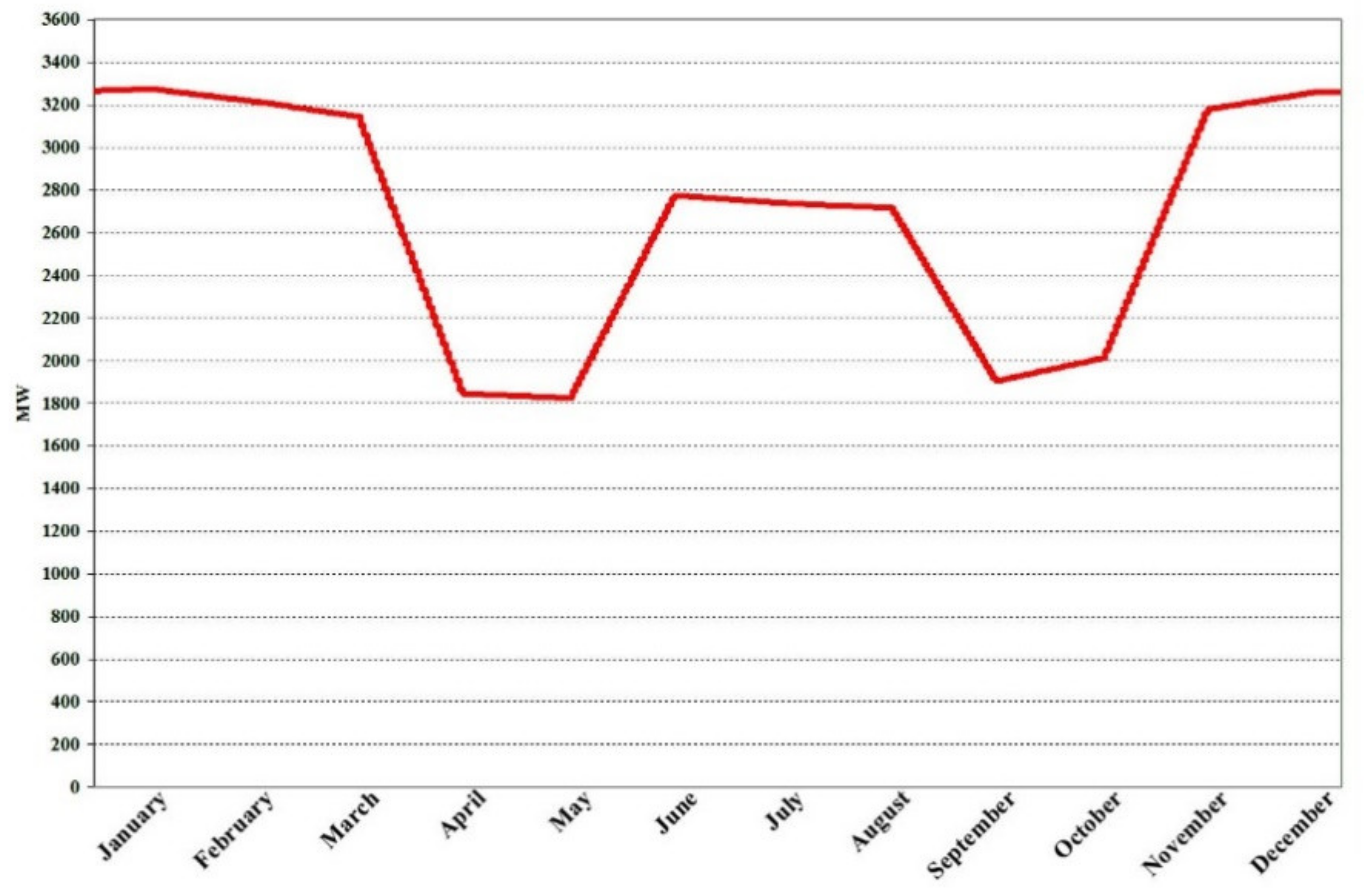
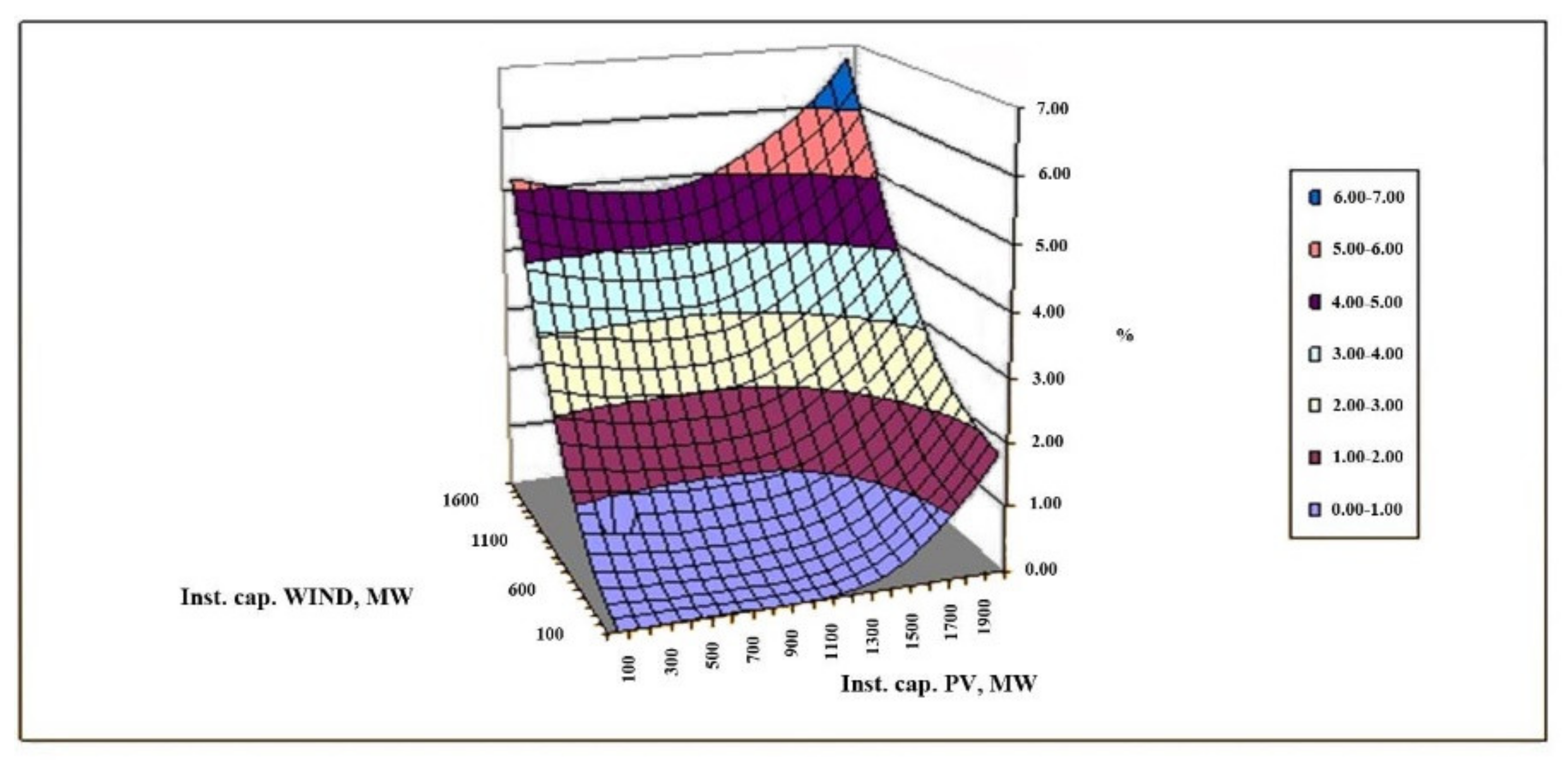
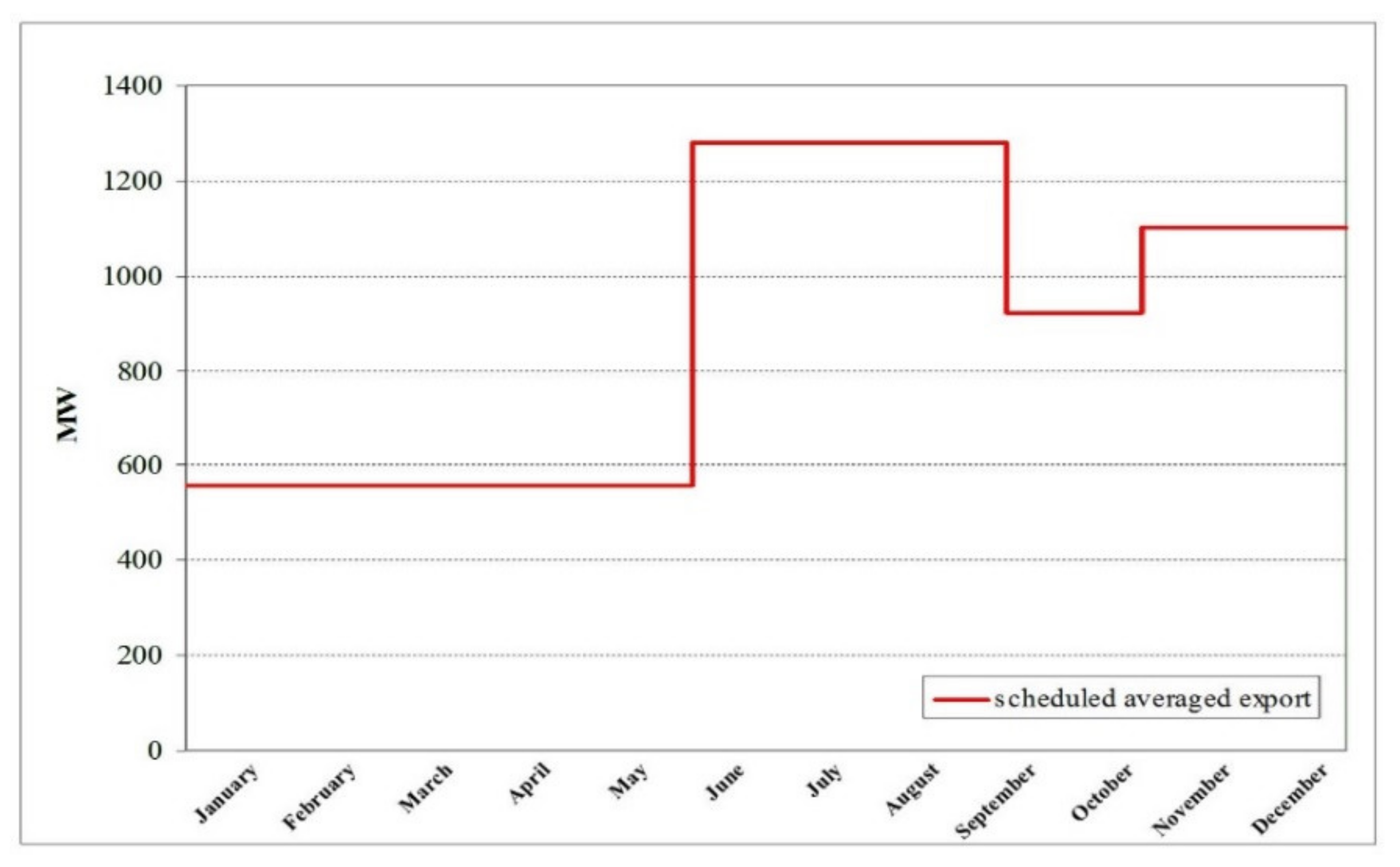
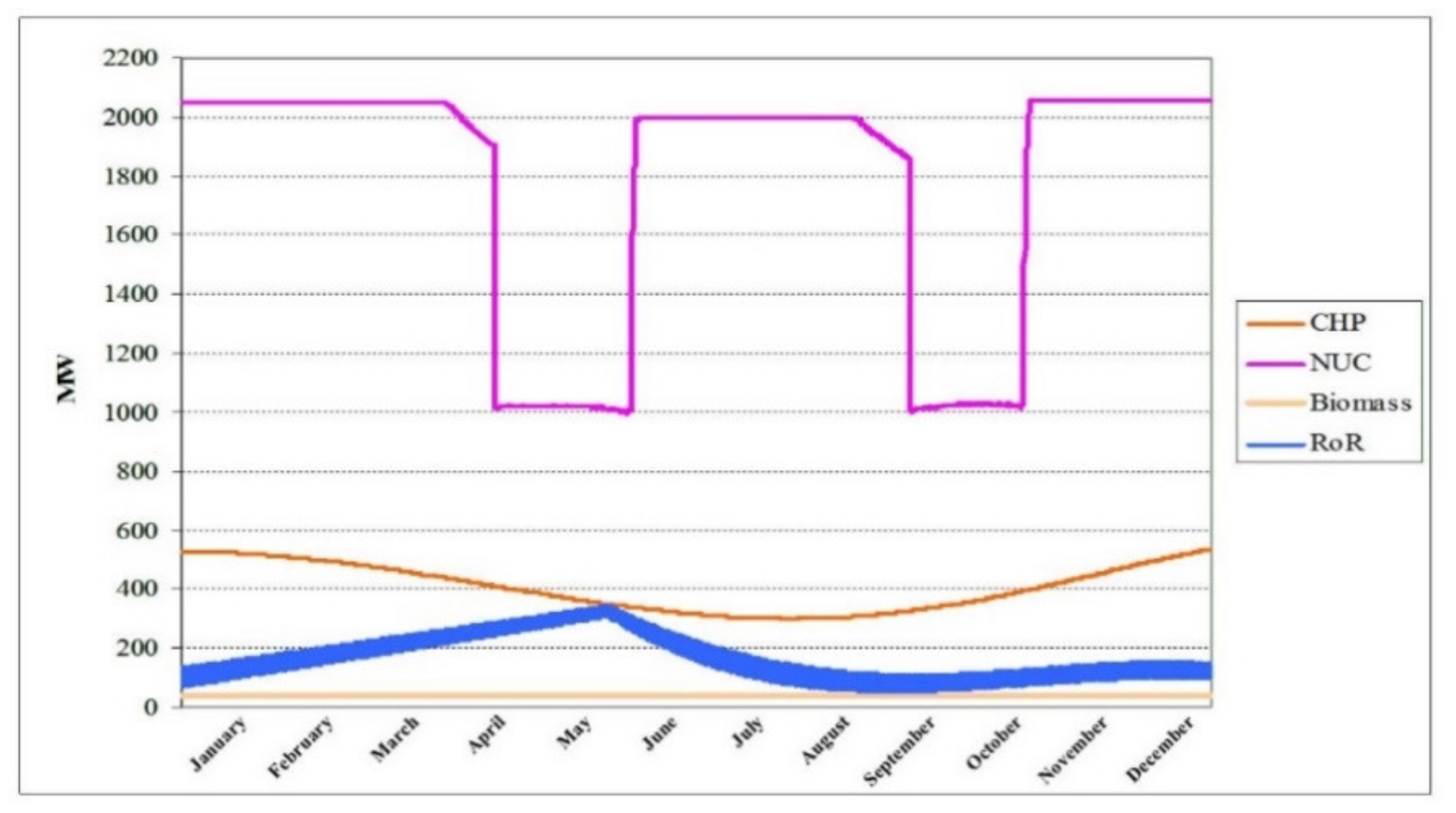
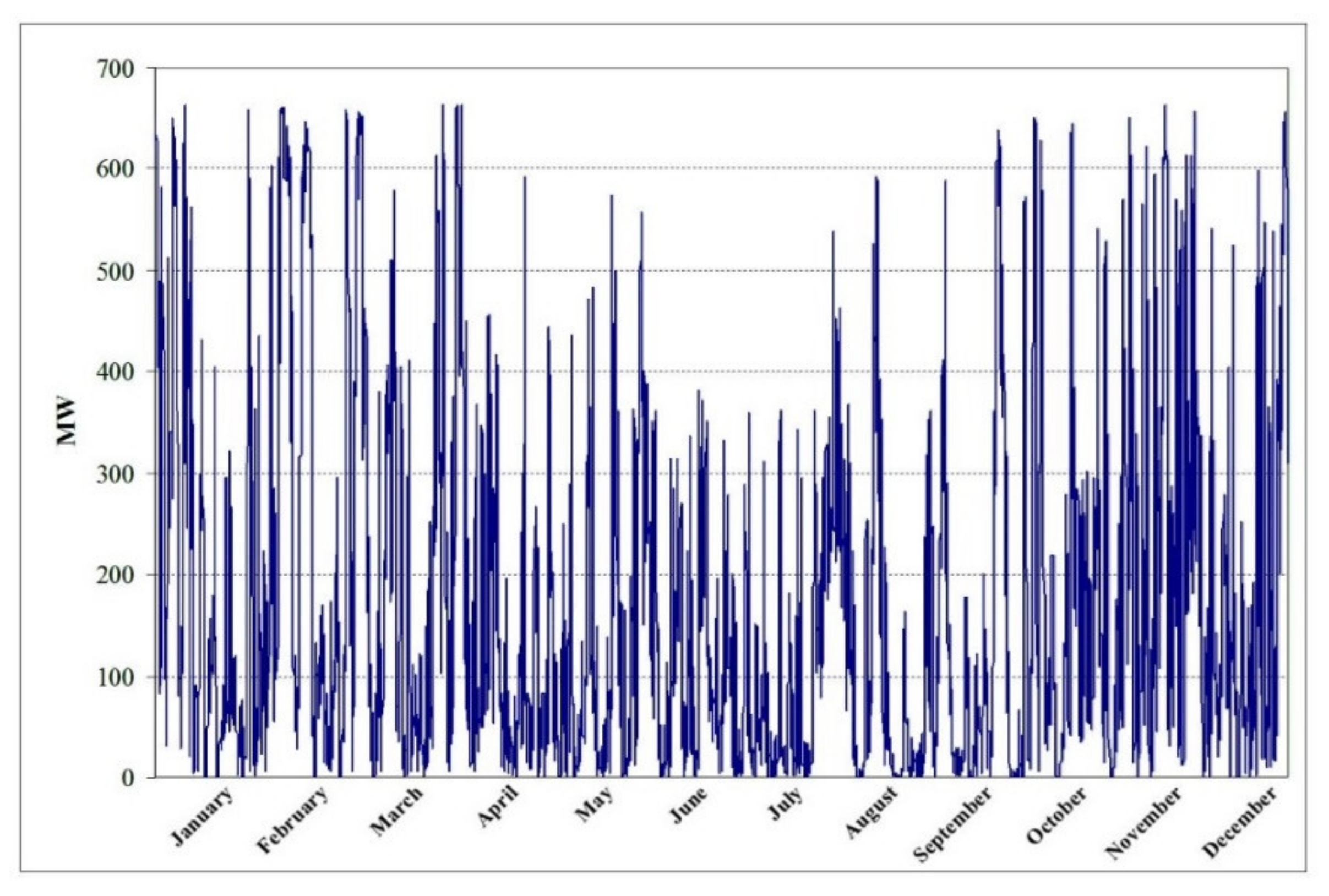
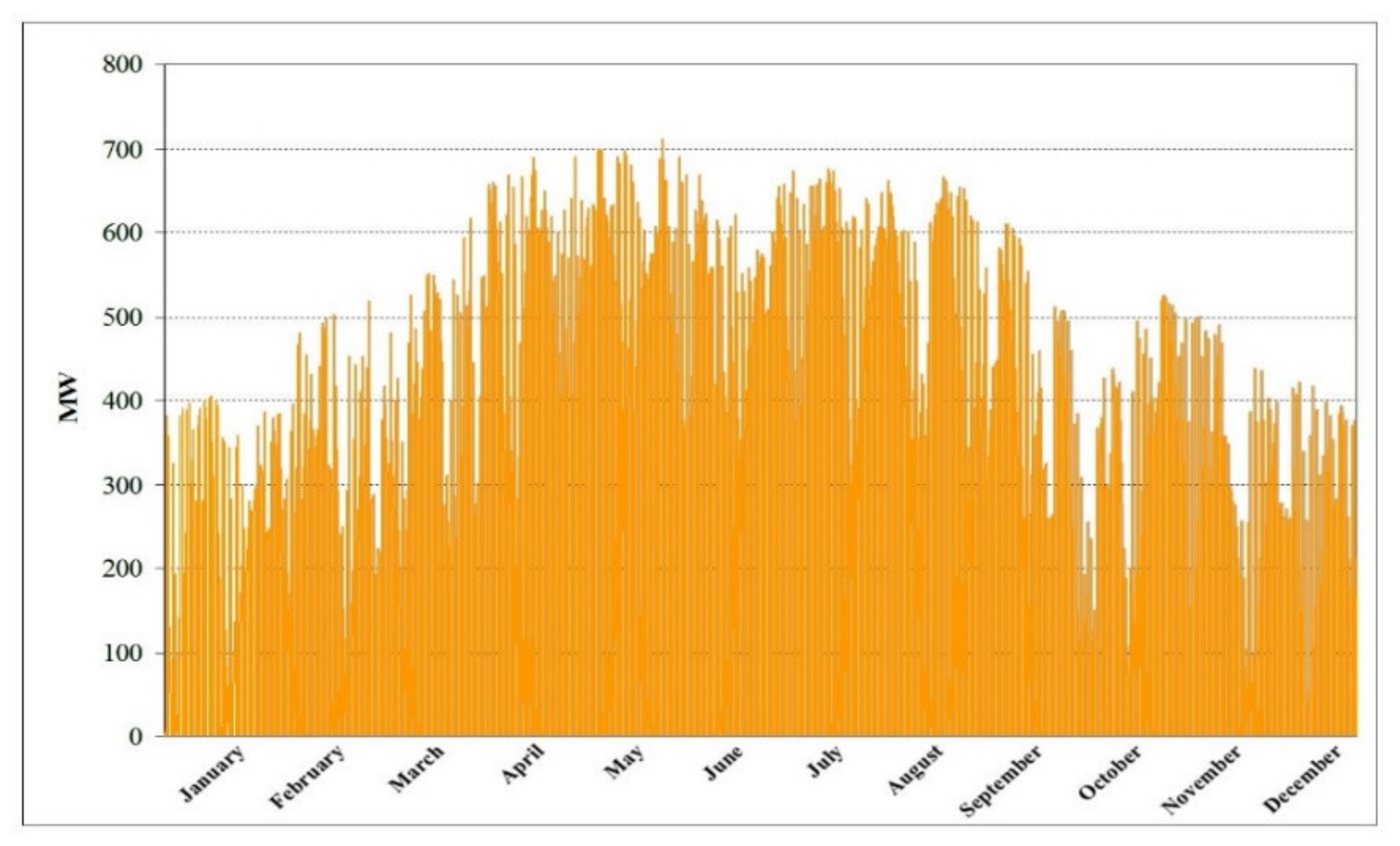
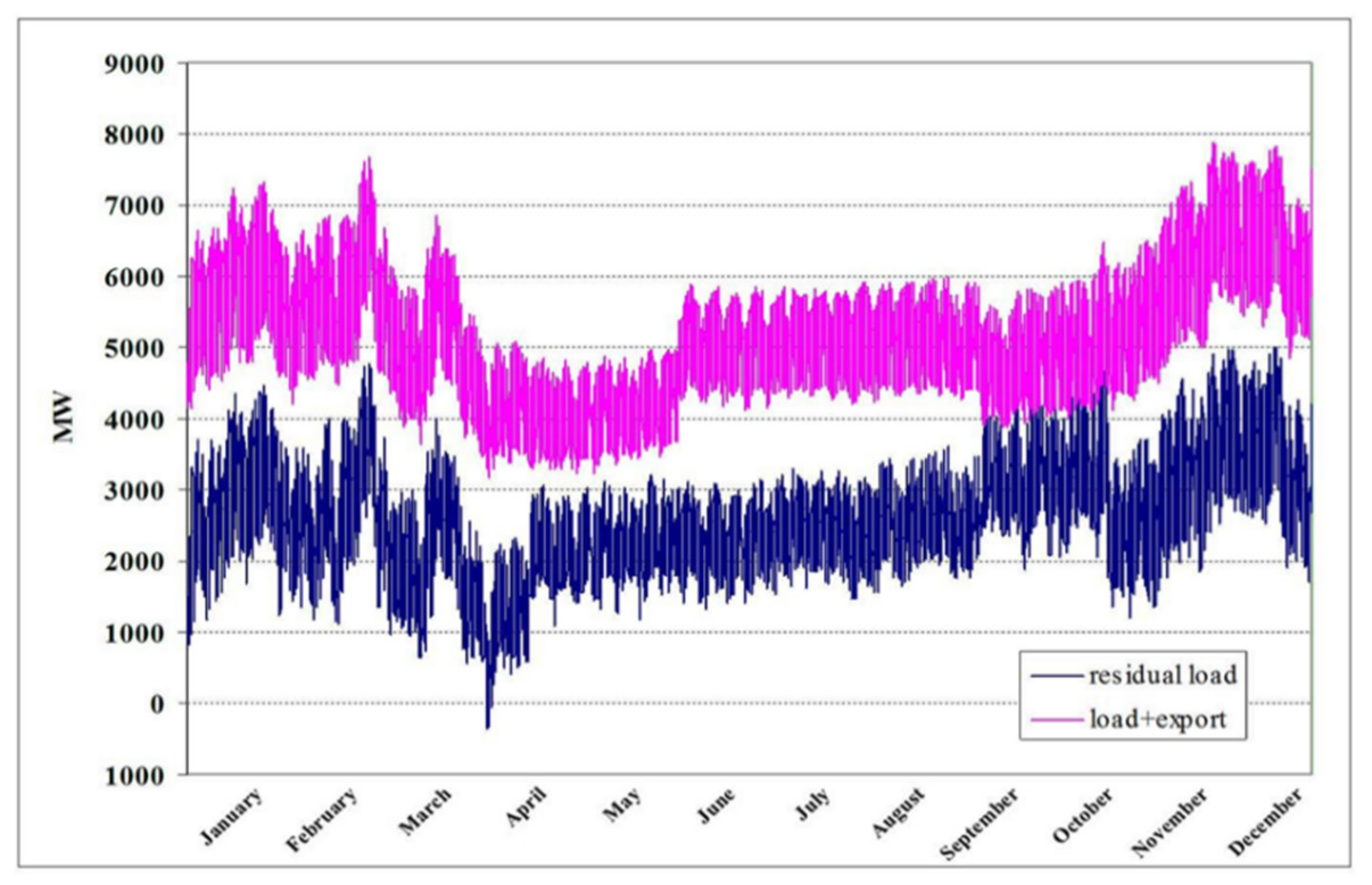
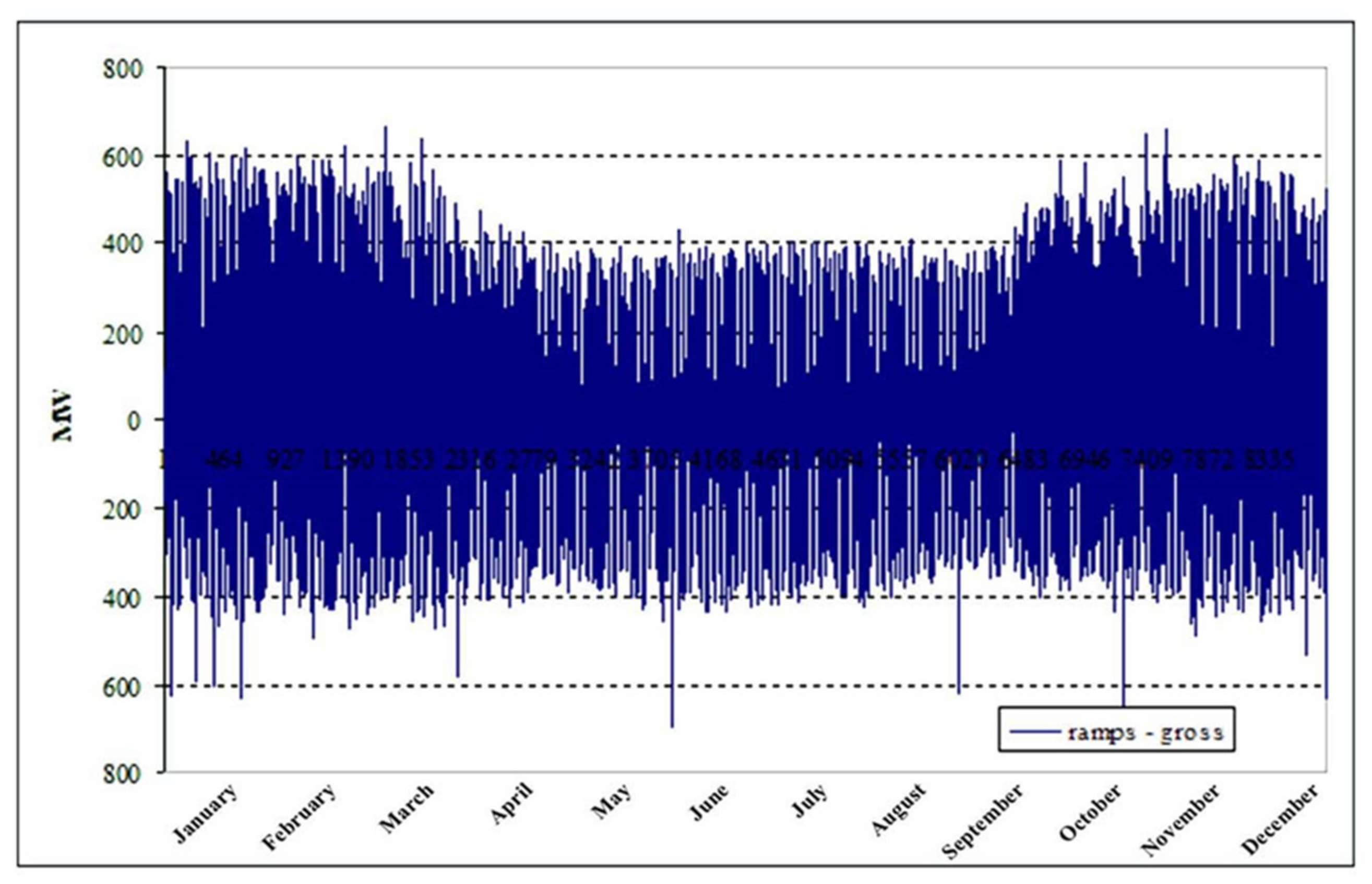
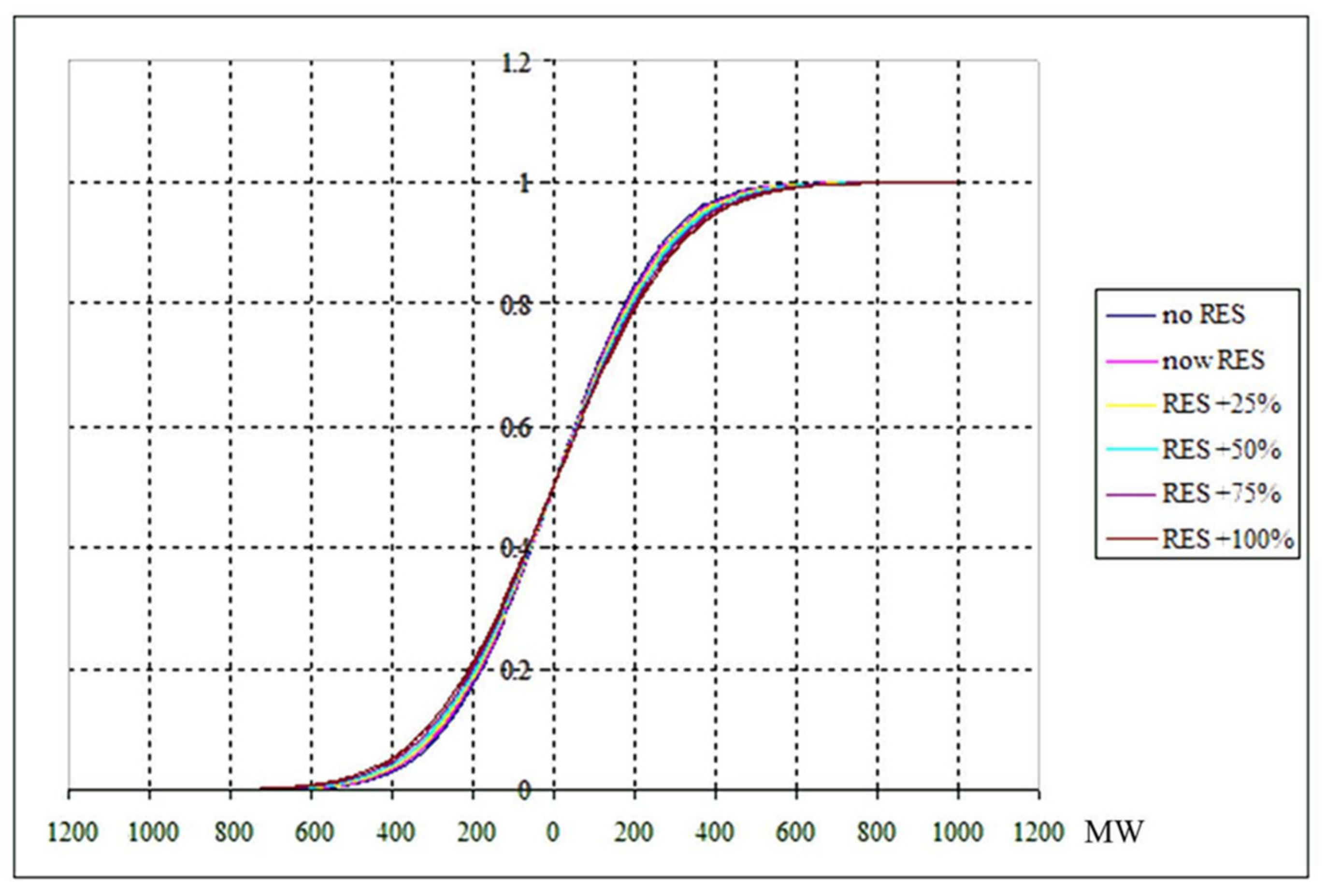
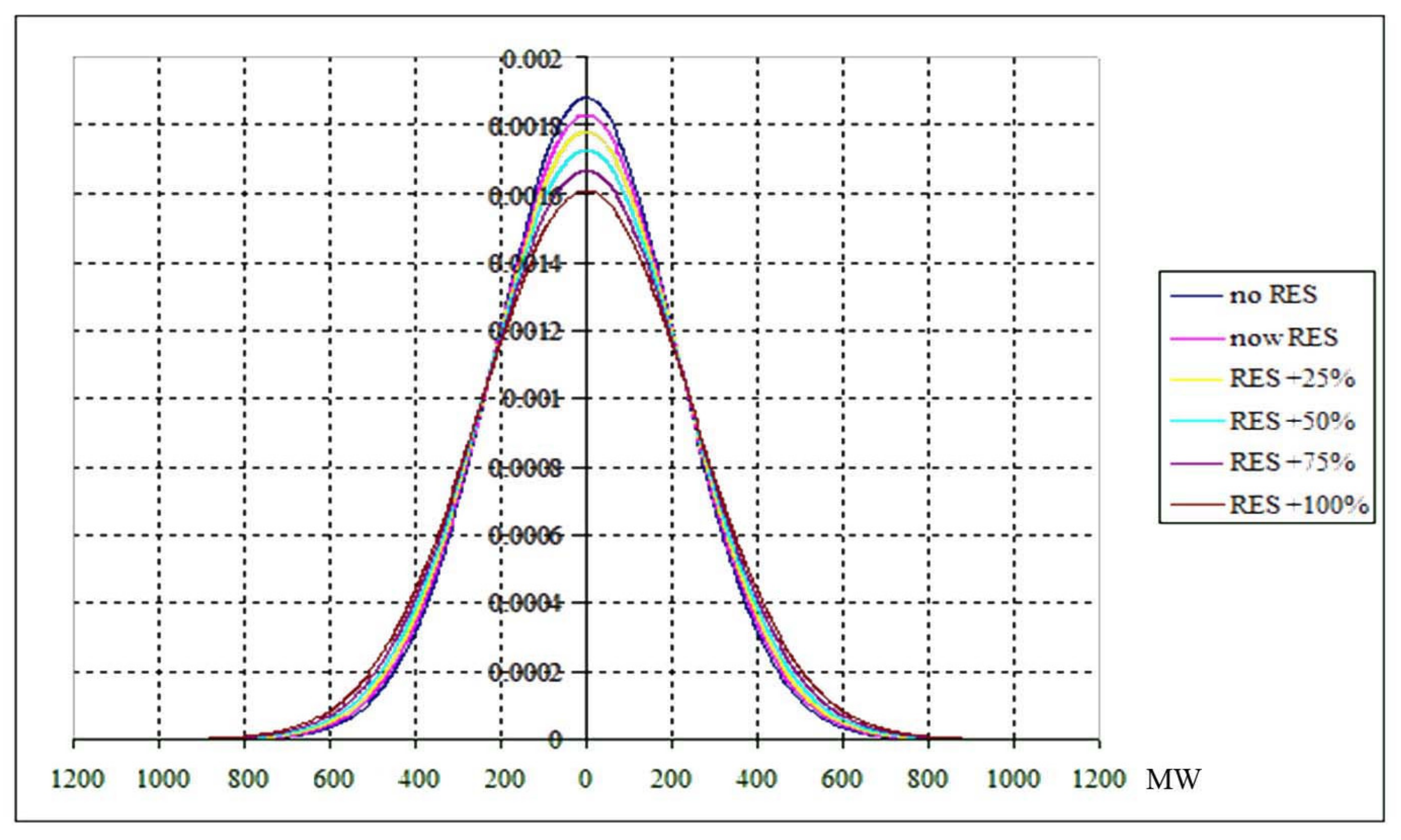
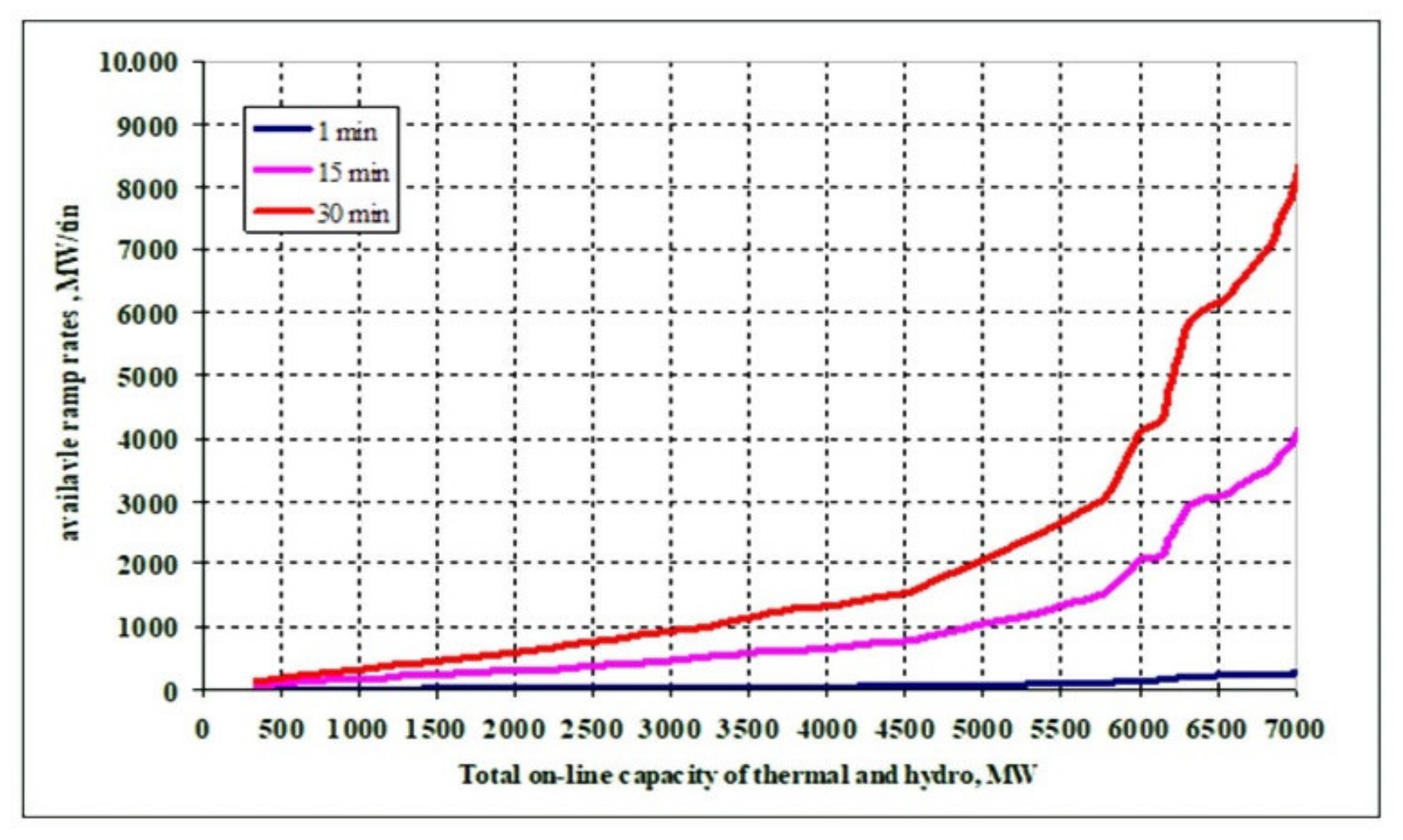
| Day with: | Gross Total Load | Residual Load | Difference % | |
|---|---|---|---|---|
| highest consumption, MWh | 145,523 | 139,491 | −6032.4 | −4.1 |
| lowest consumption, MWh | 78,339 | 68,167 | −10,171 | −13.0 |
| highest maximum load, MW | 7106 | 6699 | −407.03 | −5.7 |
| lowest maximum load, MW | 3747 | 3558 | −188.17 | −5.0 |
| lowest minimum load, MW | 2656 | 2285 | −371.66 | −14.0 |
| highest minimum load, MW | 4890 | 4695 | −195.07 | −4.0 |
| highest difference between maximum and minimum load, MW | 2672 | 2686 | 14.2454 | 0.5 |
| lowest difference between maximum and minimum load, MW | 920 | 947 | 26.6213 | 2.9 |
| highest density coefficient of the load profile | 0.9161 | 0.8811 | −0.035 | −3.8 |
| lowest density coefficient of the load profile | 0.7566 | 0.6943 | −0.0623 | −8.2 |
| highest hourly ramp up rate of the load, MW/h | 724 | 753 | 28.9324 | 4.0 |
| highest hourly ramp down rate of the load, MW/h | −686 | −734 | −48.721 | 7.1 |
| largest standard deviation of the hourly fluctuations, MW | 311 | 326 | 14.7274 | 4.7 |
| smallest standard deviation of the hourly fluctuations, MW | 141 | 141 | −0.3035 | −0.2 |
| longest series of consecutive increase of the hourly load | 11 | 15 | 4 | 36.3 |
| longest series of consecutive decrease of the hourly load | 11 | 11 | 0 | 0 |
| largest value within a series of hourly load increase, MW | 2017 (8) | 2123 (7) | 106 | 5.2 |
| largest value within a series of hourly load decrease, MW | −2283 (9) | −2416 (9) | 133 | 5.8 |
| Yearly Average Value of: | Gross Total Load | Residual Load | Difference | |
|---|---|---|---|---|
| % | ||||
| daily demand, MWh | 101,030 | 94,065 | −6964.9 | −6.9 |
| daily maximum load, MW | 4986 | 4841 | −145.1 | −2.9 |
| daily minimum load, MW | 3320 | 3144 | −176.94 | −5.3 |
| difference between maximum and minimum load in a single day, MW | 1665 | 1697 | 31.839 | 1.9 |
| density coefficient of the load profile (Pave/Pmax) | 0.846 | 0.809 | −0.0369 | −4.4 |
| highest hourly ramp up rate of the load in a single day, MW/h | 431 | 424 | −6.8265 | −1.6 |
| highest hourly ramp down rate of the load in a single day, MW/h | −408 | −416 | −8.262 | 2.0 |
| standard deviation of the hourly fluctuations of the load, MW | 214 | 223 | 9.2246 | 4.3 |
| Residual Load | Hours |
|---|---|
| Nabs.min | 2794 |
| Nmin.gen | 171 |
| Residual Load | Hours |
|---|---|
| Nabs.min | 3764 |
| Nmin.gen | 936 |
| Main Flexibility Parameter | Energy Regime Indicators Used to Evaluate Flexibility Parameters | ||||||
|---|---|---|---|---|---|---|---|
| Parameter 1 | Indicator 1 | - | - | Indicator 4 | Indicator 5 | - | - |
| Parameter 2 | - | - | Indicator 3 | - | - | - | - |
| Parameter 3 | - | Indicator 2 | - | - | - | Indicator 6 | Indicator 7 |
| № | Regime Indicators | Contribution of 1 MW | Contribution of 1 MW |
|---|---|---|---|
| Wind | PV | ||
| 1 | st. dev. of the hourly fluctuations of the residual load | 0.00 | 0.02 |
| 2 | absolute yearly minimum residual load | −0.80 | −0.57 |
| 3 | max. 24-h range of the residual load variation | 0.54 | 0.00 |
| 4 | max. positive hourly gradient of the residual load | 0.00 | 0.02 |
| 5 | max. negative hourly gradient of the residual load | −0.01 | 0.00 |
| 6 | number of hours in the year in which the residual load is lower than the absolute minimum annual gross total load | 0.80 | 0.77 |
| 7 | number of hours in the year in which the residual load is lower than the corresponding minimum admissible generation | 0.55 | 0.39 |
| Regime Indicators | Wind Power Plant | PV Power Plant |
|---|---|---|
| Indicator 1 | Do not affect the variation in a time section | 20 kW of back up power must be provided for each MW of PV |
| Indicator 2 | Have a grater “negative” impact on the absolute residual load on an annual basis | Each MW PV plant will reduce residual load by 570 kW |
| Indicator 6 | Each MW Wind power plant reduces the absolute minimum residual load during the year by 0.8 h | Each MW PV plant reduces the absolute minimum residual load during the year by 0.77 h |
| Indicator 7 | The hours of the year in which the EES has minimal technical capacity to cope with the minimum load are increased by 0.55 h for each MW Wind power | The PV’s has less influence on the hours of the year in which the EES has minimal technical capacity to handle the minimum load. Each MW PV power plant reduce the minimum technical capacity by 0.39 h |
| Index (MW) | Gross Total Load | Residual Load |
|---|---|---|
| 3394 | 3124 | |
| 9281 | 8624 | |
| −899 | −974 | |
| 1110 | 1073 | |
| 272 | 285 |
| Index (MW) | Gross Total Load | Residual Load |
|---|---|---|
| 3252 | 2661 | |
| 8407 | 7686 | |
| −761 | −903 | |
| 865 | 848 | |
| 247 | 268 |
| Increase, % | Wind, MW | PV, MW |
|---|---|---|
| 0% | 700 | 1040 |
| 25% | 875 | 1300 |
| 50% | 1050 | 1560 |
| 75% | 1225 | 1820 |
| 100% | 1400 | 2080 |
| No RES | Now RES | RES + 25% | RES + 50% | RES + 75% | RES + 100% | |
|---|---|---|---|---|---|---|
| Mx MW | 0 | 0 | 0 | 0 | 0 | 0 |
| σx MW | 212 | 218 | 224 | 231 | 239 | 248 |
| Power Plant | Unit № | Pins, MW | Pmin, MW | Pmax, MW | Ramp Rate, MW/min | Time to Ramp from Pmin to Pmax, min |
|---|---|---|---|---|---|---|
| TPP MI 1 AES Galabovo | 1 | 345 | 150 | 343 | 4 | 48 |
| 2 | 345 | 150 | 343 | 4 | 48 | |
| TPP MI 2 | 1 | 177 | 135 | 172 | 1.5 | 25 |
| 2 | 162 | 135 | 157 | 1.5 | 15 | |
| 3 | 172 | 135 | 167 | 1.5 | 21 | |
| 4 | 172 | 135 | 172 | 1.5 | 25 | |
| 5 | 225 | 155 | 222 | 2 | 34 | |
| 6 | 225 | 155 | 222 | 2 | 34 | |
| 7 | 227 | 155 | 225 | 2 | 35 | |
| 8 | 227 | 155 | 225 | 2 | 35 | |
| TPP MI 3 Contour Global | 1 | 227 | 147 | 227 | 2.7 | 30 |
| 2 | 227 | 147 | 227 | 2.7 | 30 | |
| 3 | 227 | 147 | 227 | 2.7 | 30 | |
| 4 | 227 | 147 | 227 | 2.7 | 30 | |
| TPP Bobod dol | 1 | 190 | 140 | 190 | 3 | 17 |
| 2 | 190 | 140 | 190 | 3 | 17 | |
| 3 | 190 | 140 | 190 | 3 | 17 | |
| TPP Maritsa 3 | 1 | 100 | 85 | 100 | 0.8 | 19 |
| TPP Ruse | 1 | 100 | 85 | 100 | 0.8 | 19 |
| TPP Varna | 1 | 210 | 110 | 210 | 3 | 33 |
| 2 | 210 | 110 | 210 | 3 | 33 | |
| 3 | 210 | 110 | 210 | 3 | 33 |
| No RES | Now RES | RES + 25% | RES + 50% | RES + 75% | RES + 100% |
|---|---|---|---|---|---|
| 0.0239 | 0.0272 | 0.0305 | 0.0347 | 0.0396 | 0.0453 |
| No RES | Now RES | RES + 25% | RES + 50% | RES + 75% | RES + 100% |
|---|---|---|---|---|---|
| 2640 | 2667 | 2724 | 2793 | 2860 | 2930 |
| No RES | Now RES | RES + 25% | RES + 50% | RES + 75% | RES + 100% |
|---|---|---|---|---|---|
| 2640 | 2667 | 2724 | 2793 | 2860 | 2930 |
| Power Plant | Unit № | Pins, MW | Pmin, MW | Pmax, MW | Ramp Rate, MW/min | Time to Ramp from Pmin to Pmax, min |
|---|---|---|---|---|---|---|
| PSHPP Chaira | 1 | 216 | 130 | 216 | 8 | 11 |
| 2 | 216 | 130 | 216 | 8 | 11 | |
| 3 | 216 | 130 | 216 | 8 | 11 | |
| 4 | 216 | 130 | 216 | 8 | 11 | |
| PSHPP Belmeken | 1 | 75 | 5.2 | 72 | 3.6 | 19 |
| 2 | 75 | 5.2 | 72 | 3.6 | 19 | |
| 3 | 75 | 5.2 | 72 | 3.6 | 19 | |
| 4 | 75 | 5.2 | 72 | 3.6 | 19 | |
| 5 | 75 | 5.2 | 72 | 3.6 | 19 | |
| HPP Sestrimo | 1 | 120 | 15 | 120 | 17.5 | 6 |
| 2 | 120 | 15 | 120 | 17.5 | 6 | |
| HPP Momina klisura | 1 | 61 | 22.5 | 61 | 3 | 13 |
| 2 | 61 | 22.5 | 61 | 3 | 13 | |
| HPP Batak | 1 | 11.7 | 1 | 11.2 | 4 | 3 |
| 2 | 11.7 | 1 | 11.2 | 4 | 3 | |
| 3 | 11.7 | 1 | 11.2 | 4 | 3 | |
| 4 | 11.7 | 1 | 11.2 | 4 | 3 | |
| HPP Peshtera | 1 | 27 | 1 | 21.6 | 6.4 | 3 |
| 2 | 27 | 1 | 21.6 | 6.4 | 3 | |
| 3 | 27 | 1 | 21.6 | 6.4 | 3 | |
| 4 | 27 | 1 | 21.6 | 6.4 | 3 | |
| 5 | 27 | 1 | 21.6 | 6.4 | 3 | |
| HPP Aleko | 1 | 23.7 | 4.3 | 23.7 | 2.7 | 7 |
| 2 | 23.7 | 4.3 | 23.7 | 2.7 | 7 | |
| 3 | 23.7 | 4.3 | 23.7 | 2.7 | 7 | |
| HPP Teshel | 1 | 30 | 6 | 30 | 1.5 | 16 |
| 2 | 30 | 6 | 30 | 1.5 | 16 | |
| HPP Devin | 1 | 44 | 18 | 41 | 1.5 | 15 |
| 2 | 44 | 18 | 41 | 1.5 | 15 | |
| HPP Tsankov kamak | 1 | 43.8 | 18 | 43.8 | 3 | 9 |
| 2 | 43.8 | 18 | 43.8 | 3 | 9 | |
| PSHPP Orfei | 1 | 40 | 5 | 40 | 4 | 9 |
| 2 | 40 | 5 | 40 | 4 | 9 | |
| 3 | 40 | 5 | 40 | 4 | 9 | |
| 4 | 40 | 5 | 40 | 4 | 9 | |
| HPP Kritchim | 1 | 41 | 15 | 41 | 4 | 7 |
| 2 | 41 | 15 | 41 | 4 | 7 | |
| HPP Kardzhali | 1 | 31 | 10 | 27.5 | 5.2 | 3 |
| 2 | 31 | 10 | 27.5 | 5.2 | 3 | |
| 3 | 31 | 10 | 27.5 | 5.2 | 3 | |
| 4 | 31 | 10 | 27.5 | 5.2 | 3 | |
| HPP Studen kladenec | 1 | 16.8 | 1 | 16.8 | 4.2 | 4 |
| 2 | 16.8 | 1 | 16.8 | 4.2 | 4 | |
| 3 | 16.8 | 1 | 16.8 | 4.2 | 4 | |
| 4 | 16.8 | 1 | 16.8 | 4.2 | 4 | |
| 5 | 18 | 3 | 18 | 4.2 | 4 | |
| HPP Ivailovgrad | 1 | 38 | 5 | 38 | 3 | 11 |
| 2 | 38 | 5 | 38 | 3 | 11 | |
| 3 | 38 | 5 | 38 | 3 | 11 |
| Increase, % | Wind, MW | PV. MW | Number of Hours with Residual Load < 600 MW | Number of Hours with Residual Load < 1000 MW |
|---|---|---|---|---|
| 0% | 700 | 1040 | 66 | 259 |
| 25% | 875 | 1300 | 123 | 336 |
| 50% | 1050 | 1560 | 169 | 436 |
| 75% | 1225 | 1820 | 236 | 542 |
| 100% | 1400 | 2080 | 343 | 676 |
Publisher’s Note: MDPI stays neutral with regard to jurisdictional claims in published maps and institutional affiliations. |
© 2021 by the authors. Licensee MDPI, Basel, Switzerland. This article is an open access article distributed under the terms and conditions of the Creative Commons Attribution (CC BY) license (https://creativecommons.org/licenses/by/4.0/).
Share and Cite
Mladenov, V.; Chobanov, V.; Georgiev, A. Impact of Renewable Energy Sources on Power System Flexibility Requirements. Energies 2021, 14, 2813. https://doi.org/10.3390/en14102813
Mladenov V, Chobanov V, Georgiev A. Impact of Renewable Energy Sources on Power System Flexibility Requirements. Energies. 2021; 14(10):2813. https://doi.org/10.3390/en14102813
Chicago/Turabian StyleMladenov, Valeri, Vesselin Chobanov, and Angel Georgiev. 2021. "Impact of Renewable Energy Sources on Power System Flexibility Requirements" Energies 14, no. 10: 2813. https://doi.org/10.3390/en14102813
APA StyleMladenov, V., Chobanov, V., & Georgiev, A. (2021). Impact of Renewable Energy Sources on Power System Flexibility Requirements. Energies, 14(10), 2813. https://doi.org/10.3390/en14102813








